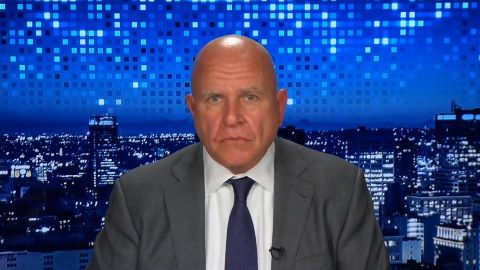Read Transcript EXPAND
CHRISTIANE AMANPOUR: Now, numbers and measurements can often be shocking. So how about this one, the global coronavirus death toll is about to hit 1 million. In the United States alone, it has claimed over 200,000 lives and that’s the worst hit. A new study says that in America, black and Latino people are twice as likely to test positive as white people. Our next guest has explored this disaster writing an article in The Washington Post called ‘The racist history that explains why some communities don’t have enough ICU beds’. Well, that headline tells it all. George Aumoithe is an Assistant Professor of Global Health at Stony Brook University in New York. And here he is talking to our Michel Martin, about the history of America’s health care policy.
MICHEL MARTIN: Thank you, Christiane. Professor George Aumoithe, thank you so much for joining us.
GEORGE AUMOITHE, ASSISTANT PROFESSOR OF GLOBAL HEALTH, STONY BROOK UNIVERSITY: Thanks for having me, Michel.
MARTIN: You’ve just written a fascinating piece for the Post that I’ll just start where you started. I mean,, obviously, many Americans have become aware that the number of deaths in the United States per capita far exceeds that of other countries, so similarly developed countries, I think many Americans have become aware that black Americans and other people of color have been disproportionately harmed. And you say that this should cause outrage, but it should not come as a surprise. And the particular thing that you point to is the lack of ICU beds in low income communities. There are many communities low-income communities that have no intensive care units at all. And I think that that might come as a shock to people given that we know that many people who live in poverty tend to have more chronic health conditions, often don’t seek medical care until they’re already in an acute sort of state. So how did this happen?
AUMOITHE: Well, Michel, the answer is actually quite straightforward. If you take a look at the policies, beginning in the ’70s, during the inflationary crises that beset cities like New York City, as well as the nationwide economy, there was a turn towards economizing. And the idea that health policy experts had at the time was that a traditional occupancy rate of around 75 percent was falling down to 60 percent and that this was a sign that there were too many empty hospital beds that this was wasteful spending and that the organization of care could be rationalized. So what began to happen, particularly after the formal desegregation of these facilities was this logic that because we no longer had white only and colored hospitals, that fewer hospitals were needed, bad hospitals could be consolidated, that specialty care could be concentrated. The unfortunate result of this policy though, was to remove specialty care from a lot of inner city and rural hospitals and to place them closer to suburbs were majority populations were moving to and commuting away from into the city. So the idea was even though these inner city hospitals once had ICU beds and had obstetrics and had cancer care, why not just leave the emergency services and the outpatient services where they’re needed and allow anyone with chronic conditions to travel a little further to a newer facility that had a sort of concentrated range of services. And so over time from the 70s through the present day, even through the AIDS epidemic, even through major disease crises, policymakers continued to pursue this economizing, this concentration of resources under the logic that it would save more money. And today we have 50 percent of people in low-income communities without any ICU beds.
MARTIN: Fifty percent of people in low income communities have no ICU beds at all. Now, I think people who are minimally educated about racial history in this country know that segregation was a fact of life and that some communities, that black communities always had inferior facilities or fewer facilities. At some point that changed, the hospitals were desegregated under the law. So this sort of concentration of specialized care in these suburban areas, which just tend to be less integrated, tend to be more white, was that intentional? I mean, was it intended to deprive these communities of this kind of care or was it the unfortunate byproduct of a race neutral point of view?
AUMOITHE: Right. So that’s sort of the difficulty and comprehending the history and, perhaps, the element that is most surprising is this idea of intentionality, this idea that there’s sort of racist animus behind these policies. But when you look at the health policy literature, this was actually kind of across the board assumption that infectious disease was on the decline, that chronic disease was on the rise, that inpatient acute care, so staying in a hospital getting cared for was more expensive than just giving someone a drug and following up with them outside of the hospital. So all of these assumptions about the quality of care were undergirding the shift. With that said, it can’t be disconnected from the era of segregation. In fact, the very law that the federal government passed in 1946, the hospital modernization and reconstruction act commonly known as Hill-Burton, allowed and actually wrote into statute the Plessy v. Ferguson doctrine of separate but equal. So that 1896 doctrine was allowed to be written into this 1946 law. What was equitable about Hill-Burton was that it included a clause that mandated that funding could not be concentrated in any one geographic area. So a suburb would get the first grant and then when it rolled over, it would go to a rural area and then when it rolled over it’ll go to the city. So this actually allowed the United States to build over 6,000 healthcare facilities between 1946 and 2000. But Hill-Burton also changed a lot. And by the time you get to the Civil Rights Act, and you get to the desegregation drives by the Health, Education and Welfare Department at the time, by the early ’70s, desegregation was achieved. So the whole doctrine of intentionality of being intentionally racist that was at the core of civil rights law and at the core of the federal government’s mission to desegregate these hospitals was, in many ways, solved. We no longer had segregated hospitals. But when the economic crisis of the ’70s hit, this opened a new window to take away that equitable funding around Hill-Burton and to concentrate it. And so with the National Health Resources Act of 1974, the federal government for the first time changes this funding structure and allows municipalities to concentrate that funding into a lesser areas, but with more flexibility.
MARTIN: So what happened, as I’m hearing it, is that actually some of these early sort of funding mechanisms improved health care across the country, because it poured resources into hospitals both in cities and in suburbs, emerging suburbs and rural areas. It probably lifted the quality for everybody.
AUMOITHE: Absolutely.
MARTIN: Even though it was segregated, but then subsequently this sort of drive to concentrate the funding, move those resources out of areas where most people of color live, particularly black people. Does this arise from kind of racist thinking or does this arise just from an overall philosophy around health care that is just different in the United States than in other countries with resources? I mean, one of the things that you point out in the piece is that the United States has just 2.9 hospital beds for a thousand people compared to 3.1 in Italy, 4.3 in China and 13 in Japan, why is that?
AUMOITHE: I think that’s an important question, Michel. And I think that we have an unfortunate tendency in our thinking to separate questions of race from questions of class. When you go all the way back to the New Deal, there was no exclusion formally in the law of black people from the New Deal. What there was, was an exclusion of every domestic and agricultural worker 90 percent of whom were black. So there were already, from the inception of social security in this country, exclusions carved out on the lines of occupation, which just mapped onto race. So again, if you’re searching for intentional animists, you’re more likely to find it in the 40, the 30s, 40s up to 60s than you are after the sort of formal legal victories of the civil rights movement. And what you see in this country is a turn towards the market and towards a private accommodation for care. So this assumption that particularly after the fiscal crisis in the ’70s, cities just don’t need to be in the business of providing care, private voluntary hospitals can provide that care. And we have a strong tradition of that Catholic and Jewish hospitals, publicly serving hospitals that serve a poor or working poor people or underinsured people. But it leaves a lot to charity, rather than a sense of right to health care and that is the biggest distinction between our country and other similarly situated industrialized countries is that per capita, we do spend more on health care provision, because we insure it, we rely on private insurance to deliver that right and we rely inordinately on private hospitals to deliver that care.
MARTIN: This kind of under resourcing affects people who live in very different places, rural areas, for example, what happened there? I mean, you could argue that under sort of our constitutional system, rural areas have more political power that you would think that they were given their populations. So why are they experiencing the exact same thing?
AUMOITHE: The biggest, I think, explanation for the lack of resources in the rural south, goes all the way back to the mid 19th century, the Civil War. When you have the emancipation of enslaved persons and the complete destruction of the industrial capacity of the south, the South became very poor, relative to the north and other parts of the country. So over these years, the redevelopment of these regions of the country, the South in particular, so economic redevelopment took precedence over any sorts of welfare right. And I argue that this has an impact through today, even though the south can be seen as economically recovered in many ways. It’s growing in terms of population in many ways, places like Charlotte, our major banking centers, it hasn’t translated in the same way into municipal right in places like New York or Chicago, mainly because labor rights, people’s right to organize and to demand basic human rights and health care rights have never gained traction in the south the way that it did in places like New York.
MARTIN: This is so fascinating, because part of the point that you make is that civil rights law hasn’t really applied here, in part, because race may be at the core of it, but it really overlaps more with income. And your ability to kind of negotiate for yourself based on income, which is why people in sort of rural areas, whether they’re white or black are facing the same kinds of issues as people who are low-income cities. So talk about the current sort of moment, if you will, health care, access to health care continues to be one of the organizing kind of arguments of the political moment. How do you see it playing out?
AUMOITHE: We have a problem of racial resentment, an idea that programs like Medicare and Medicaid are welfare medicine programs that only benefit black and brown people. When, in fact, a majority of poor white working class people rely on Medicaid. And so, there’s a whole issue around the ways in which Medicaid has been portrayed and vilified and stigmatized that really needs to be reckoned with. I see two main things, obviously, this current administration seeks to repeal and ‘replace’, there’s not been very much detail about what to replace that with. But they certainly want to repeal and return on health care provision for the market, towards a model that existed before Obamacare. Whereas the Biden campaign seeks to restore Obamacare and re- establish Medicaid as one of the main central planks for providing that care to people. When it comes to Medicaid, Medicaid expansion is super important. But southern states in particular have been highly reticent against expanding Medicaid, mainly because unlike Medicare, which is 100 percent funded by the federal government, Medicaid is a state federal government cost sharing agreement. The one bright spot, though, is a recent voter referendum in Missouri where voters there voted to expand Medicaid finally, against the wishes of the prevailing governor there and the legislature there. So there are certain routes, if populations are organized enough to achieve something like Medicaid expansion.
MARTIN: Can I clarify something from you that just – say this again.
AUMOITHE: Yes.
MARTIN: You said that the majority of poor, lower income white working class people use Medicaid.
AUMOITHE: Yes.
MARTIN: Does that also mean that white people are the majority of people on Medicare?
AUMOITHE: Absolutely. Yes, absolutely.
MARTIN: I would imagine that most people don’t know that. You’re saying the majority of people who use Medicaid are white.
AUMOITHE: Yes. It’s connected to the same obfuscation that occurred, for example, in the Reagan years, when Reagan accused for mothers, for black mothers, in particular, as being welfare queens. This whole discourse, really distorted people’s perception of who uses public benefits. You get strange permutations like white working class voters in Mississippi saying, I want the government to take its hands off my Medicare.
MARTIN: Don’t they know they get their health care that way? I mean, presumably, they know that that’s how they get their health care, right? I mean, do they not know that?
AUMOITHE: You would think, but it just points to how much public benefits have been racialized in this country, how they’ve been described as just a entitlement for black people, brown people and even now immigrants.
MARTIN: I’m still sort of puzzled by why we have such a different view of this than other countries in the world that are similarly resourced. This is a very wealthy country and it’s also a country that highly values work. Is it really the case that people don’t see the connection between being healthy and being able to work that people who have chronic health conditions, people who don’t have access to care, it’s very hard to be productive when you’re sick.
AUMOITHE: We don’t see it for one main reason, it’s because we do not have a Labour Party in this country.
MARTIN: OK.
AUMOITHE: And without a Labour Party, you’re not going to get health care and you’re not going to get a lot of these associated benefits.
MARTIN: I think most people know that something is not right.
AUMOITHE: That’s right.
MARTIN: And you don’t have to be, I think, particularly low-income to believe something is wrong. Are you really saying it’s just because there’s no political party that specifically focuses on this and that’s why it doesn’t change?
AUMOITHE: Yes. I think that’s really a really key part. I think the Democratic Party around the New Deal coalition got about as close as this country’s ever gotten to providing a sort of universal right to health care. But again, because domestic workers and agricultural workers’ wages were not counted as a contributing Social Security, they didn’t qualify for a lot of these benefits and those workers were mostly black people. So we really need to grapple with the continuing legacy of racism in the law, and in the policy, because it really has structured, the very boundaries around who is included and under a right, who’s seen as deserving of right. And because we prioritize work, certain kinds of work, rather, and that really shapes the legacies of who can have access to these programs. Another important point I’d like to bring up is that the designer of the Medicare program actually designed the Canadian program. So the National Health Insurance Program in Canada is Medicare for All. It’s just that in this country, there was a calculation to just restrict that entitlement to those over the age of 65 and Medicaid was actually an afterthought in the legislative drafting process. So we need to realize when we look at history that because healthcare hasn’t been organized as a right for all people, regardless of race and regardless of class that it’s highly contingent upon where you live and it’s highly contingent upon the sort of political economy of the federal government. So you see when you look at this issue over time, expansion and contraction. So it’s not a given that a law like the ACA will forever guarantee coverage for those who aren’t employed or for those who lie just above the official poverty line. It’s very much incumbent upon local people organized in institutions with leverage and power on politicians and policymakers to ensure that was right stay.
MARTIN: Professors George Aumoithe, thank you so much for speaking with us.
AUMOITHE: Thank you so much, Michel.
About This Episode EXPAND
Former national security adviser H.R. McMaster reacts to The New York Times report on President Trump’s taxes. Conservationists Beverly and Dereck Joubert discuss the extraordinary global collapse in biodiversity. Global health professor George Aumoithe explains why there is a devastating shortage of ICU beds in low-income communities.
LEARN MORE


